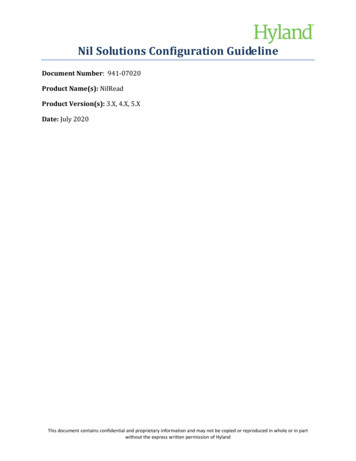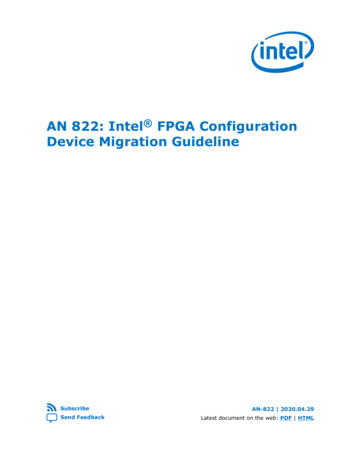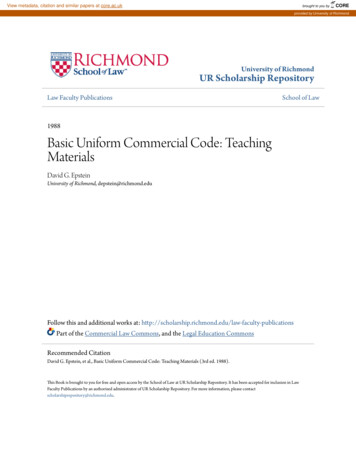
Transcription
Nil Solutions Configuration GuidelineDocument Number: 941-07020Product Name(s): NilReadProduct Version(s): 3.X, 4.X, 5.XDate: July 2020This document contains confidential and proprietary information and may not be copied or reproduced in whole or in partwithout the express written permission of Hyland
Document: 941-07020, Rev 7.01Executive SummaryHyland’s Nil family of zero footprint viewers can be used by clinical personal to view any type of DICOMor non DICOM medical images inside and outside the hospital network. Nil is available as both a clinicalreference viewer (“NilRead Clinical”), and a full diagnostic sophisticated viewer (“NilReadInterpretation”).This document is intended as a guideline to design and size a Nil deployment. It provides generalguideline and a set of example for common configurations.The high-level structure of NIL deployment on a customer site in presented on the diagram below.Figure 1 NIL Deployment StructureThe site will host one or more NIL web servers which provide user access to NIL imaging and reportingservices. If more than one server is required to serve the number of concurrent users necessary at a site,then the access to the web servers is controlled by a load balancer (e.g. F5 BIG-IP). The load balancer isconfigured with session affinity by server, which ensures that user session requests are always routed tothe same server after the initial assignment.In some user deployment scenarios each NIL server uses its own NIL database to maintain userinformation and references to the cached data. In other scenarios Nil can pull directly from an outsideDICOM archive.Page 2
Document: 941-07020, Rev 7.0Each NIL server can be configured to interface with PACS, VNA and Enterprise archives, XDS and otherdata sources. DICOM data from the configured sources can be “pushed” to NIL, which caches data on afile share accessible by each NIL server. It is also possible to query/retrieve directly from multiplesources, and also setup prefetch rules to optimize the availability of priors.NIL can be deployed in either single- or multi-tenant configurations. In the single-tenant configurationthere is only one ‘operation’ context maintained which includes user accounts, data lifecycle rules,hanging protocols, DICOM connectivity setup, and cached DICOM data. In the multi-tenant configurationmultiple operation contexts are supported – one per each ‘tenant’. Each tenant is provided with its own"Virtual NilRead Site". These "virtual NilRead Clinical Sites" share the same 'physical' NilRead Clinicalinfrastructure - front end and back end servers. Tenants are provided with a dedicated database, bydefault tenants do not have access to each other data, unless “trust” relationships are established2General GuidelinesDepending on deployment scale all NIL system components might reside on a single or multiple physicalor virtual hosts. “Mission critical” scenarios would require some level of hardware redundancy, whichcan be implemented on both on physical and virtual level.Nil can be run on either physical or virtual server; the difference in performance is negligible (as long ashardware supports virtualization). For scalable deployment and high availability it is recommended touse a virtualized environment. Nil supports scaling up the number of servers in conjunction with a frontend load balancer to address large numbers of concurrent users.2.1 System Resource RequirementsThe system resources required by Nil depend on several factors including the usage scenario (e.g. 2D,3D, etc.), resolution of monitors and expected performance (e.g interpretation vs referring physician).Nil, as any other the zero footprint solutions, is a server side rending solution. The server side does allthe heavy lifting and should be dimensioned properly. On the other end the client devices can besignificantly less powerful, and can range from workstations driving multiple high-resolution monitors tolow end desktop and all the way to tablets and smart phones.NilRead ClinicalResourceCPU typePage 3Minimum requirement based on single monitor 2.3 MpxXenon E5 @ 2.2 GHZ, recommended 2.66 GHz
Document: 941-07020, Rev 7.0# users per CPU coreMemoryApplication disk spaceBandwidthModalityMixedMostly dalityMixed1 GBMostly X-ray0.5Mostly1 GBCT/MR/USMostly1.5 GBMPR/3D20 GB2 Mb/sec in ‘local’ mode, 1 Mb/sec in internet mode.Nil Read/InterpretationResourceCPU type# users per CPU coreMemoryApplication disk spaceBandwidthMinimum requirement based on 2x 5 Mpx grayscale monitorXenon E5 @ 3.0 GHZ, recommended 3.2 GHz or betterModality#users/coreMixed2Mostly ng 1-2 priorsMixed1.5 GBMostly X-ray1.0 GBMostly2.0 GBCT/MR/USMostly2.5 GBMPR/3D20 GB5-10 Mb/sec in ‘local’ mode.For interpretation, client workstations using mix of high resolution monitors and multiple video cardsshould have a compatible drivers. When multiple video cards are installed, Nil will use OS choice interms of which video cards are used for driving the monitors. For multiple high resolution monitorseither IE 9 / Firefox/Safari can be used. IE8 will not use hardware acceleration and will be have a slowerrendering speed when driving 10Mpx. Chrome is blocking the application’s ability to set the position ofPage 4
Document: 941-07020, Rev 7.0views across multiple monitors but it will work with single ‘seamless’ dual pane monitor (such as Barco 6MPx color etc)NilRead interpretation deployments should be deployed using a ‘cache’ approach for fast access toimage pixels and metadata. To reduce the cache size, the VNA or PACS (or other pre/post fetchmechanism) should be configured to push not only the current but associated relevant priors as well, atleast those used in the typical hanging protocol with prior. A 500 GB cache will hold about 7-8K studieswhich is fine for this scenario. NilRead is able to send a notification to the Worklist/Ris when the studiesare arriving in the cache so the worklist can mark them as available for reading.Notes1. Power savings features of the hosts should be disabled. By default Xenon E3/E5/E7 are not set in‘performance’ mode and the CPU frequency is lowered causing very slow image interactionspeed. This can be changed wither in BIOS or VMware ESX.2. The number of cores is based on ‘real’ cores no vCores. If hyper-threading is on, each real core isexposed as 2 cores. In general, Nil will be faster by 10-15% if HT is disabled, for the samenumber of real cores.3. Nil requires at least 4 cores to run smoothly. For a clinical proof of concept this can be loweredto 2-3 real cores (4-6 with HT on).4. The difference in rendering speed between a VM and physical hardware is about 15%.5. If is a ‘cache’ solution and the Dicom/Cache server is running on the same system as therendering servers, it will need an extra 1-2 cores and 2-6 GB of RAM depending on the studyvolume. For heavy sites ( 250K studies/year) we recommend deploying the Dicom/Cache serveron a separate VM (2-4 cores, 6-10 GB of RAM including OS), see details in “Repository I/OCapability” section for recommended and minimum I/O benchmarks.6. Large number of concurrent users will typically use 30-50% of the total calculated bandwidthvalue due to normal interaction with the image patterns (x-rays will use very little bandwidthwhile scrolling modalities such as CT/MR and especially US/cardiology will use more)7. Nil stores by default images in RLE lossless format, which uses about 65% of original. If Nil isdeployed in a no-cache solution (reading directly from VNA) we strongly recommend using JpegLossless instead of Jpeg 2000 storage syntax as the VNA store format. Jpeg 2000 is a verycomputationally intensive format for pixel decoding and will cause slow pixel access (scrolling).In a cache setup for interpretation, Nil should be configured to not accept Jpeg 2000 throughDicom as by default Nil stores incoming ‘compressed’ data in the original format.The repository (cache) I/O capability also has a significant impact on overall performance, the followingis the recommended and minimum I/O benchmark requirements:Page 5
Document: 941-07020, Rev 7.0Repository I/O Capability (NilRead Clinical/Interpretation)BenchmarksRecommended: (SSD orsimilar):Minimum: (10K RPM, Raid 5SAN, or similar)IOPsThroughputAverage latencyLatency distribution#users/core 25,000/s 150MB/s 3ms90% 6.0msIOPsThroughputAverage latencyLatency distribution#users/core 7,000/s 50MB/s 9ms90% 12.0msNoteThe I/O capability should be verified with the Microsoft storage Testing Tool, Diskspd Spd-a-robust-storage-6cd2f223, with the following measuringparameters (the cache is located in C:\temp in the example):diskspd.exe /w10 /d300 /W30 /b8K /t1 /o8 /h /L /Z1G /c1G c:\temp\test1.dat c:\temp\test2.datc:\temp\test3.dat c:\temp\test4.dat c:\temp\test5.dat c:\temp\test6.dat c:\temp\test7.datc:\temp\test8.datThe command simulates the Nil I/O access pattern, it will run 30 seconds warm-up before measuring,followed by 300 seconds 8K block sequential I/O tests against 8 1GB test files on the target drive (C:drive in the example), using a 30% write and 70% read ratio with 8 worker threads that each leverages 8overlapped IOs and a write entropy value seed of 1GB, 1 thread per target. Software and hardware writecaching are disabled.SoftwareNIL can be deployed on all English editions of Windows Server x64 starting with 2012 R2. Nil will need asprerequisites: IIS 8.5 or newer .Net 48 or newer, Microsoft SQL Server Express 2008 SP2 or newer.For’ no-cache’ deployments or when the cache size is under 5 million images an SQL Express databasecan be used. For DR/HA deployments, the NIL database is expected to be deployed on a clusteredMicrosoft SQL Server Enterprise edition and the databases synced between primary and DR datacenters.High availability and Disaster RecoveryLarge scale NIL deployments would require usage of hardware load balancers (e.g. F5 BIG-IP) providingcookie based user session persistence, as well as HTTPS offloading. Another key factor for large scalePage 6
Document: 941-07020, Rev 7.0deployments is performance of file storage, which can be achieved by using multi-channel 10GbE orFDDI based SAN/NAS/DAS storage array.The typical medium-large scale deployment network topology is presented on Figure 2. It includes aredundant firewall/routing tier. The load balancer tier would offload SSL and redirect client requests to aserver associated with the request authentication token (implementing as “sticky” session loadbalancing). If the load balancer uses a ‘client IP’ sticky session management, the SSL offload can be doneon the Nil server. In this mode a valid wildcard SSL certificate should be installed on each of therendering servers.Nil servers run on either physical or virtual servers connected to high-throughput storage system usingeither 10GbE or FDDI channels.Page 7
Document: 941-07020, Rev 7.0Figure 2 NIL site network topology2.2 Cybersecurity Best PracticesIt is important that the Nil Systems are included in the site’s cybersecurity framework to ensureprotection of confidential patient data and continuous operation.While not exhaustive this framework should considerPage 8
Document: 941-07020, Rev 7.0-Network defenses such as Firewalls and “denial of service” appliances. Nil will normally requirejust the HTTPS port to be opened on front end servers, and DICOM/communication ports 11001104 on backend servers.-Wireless network security such as usage of appropriate encryption standards and deployment ofintrusion detection systems.-Ensure that OS is updated with security patches and an antivirus is deployed. Perform regularscan for vulnerabilities. Note that NilRead applications and images cache should be normally‘excluded’ from the ‘real-time’ antivirus protection.-Physical security to servers and network devices as well as social engineering fraud.-Incident response plans that can mitigate the risks following a cybersecurity incident.Page 9
then the access to the web servers is controlled by a load balancer (e.g. F5 BIG-IP). The load balancer is configured with session affinity by server, which ensures that user session requests are always routed to the same server after the initial assignment. In some user deployment scenarios each NIL server uses its own NIL database to maintain .










